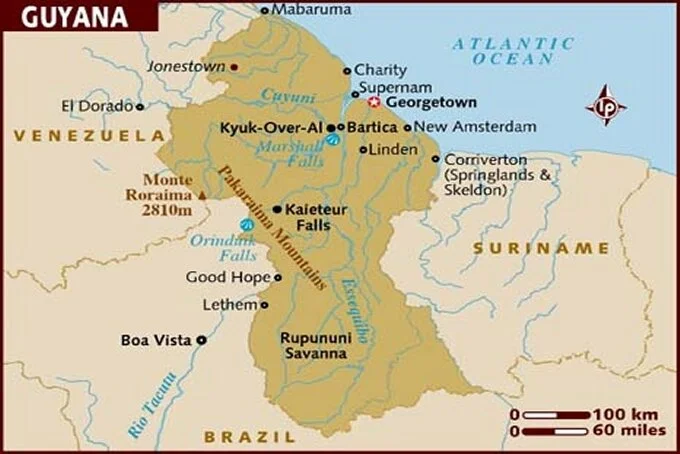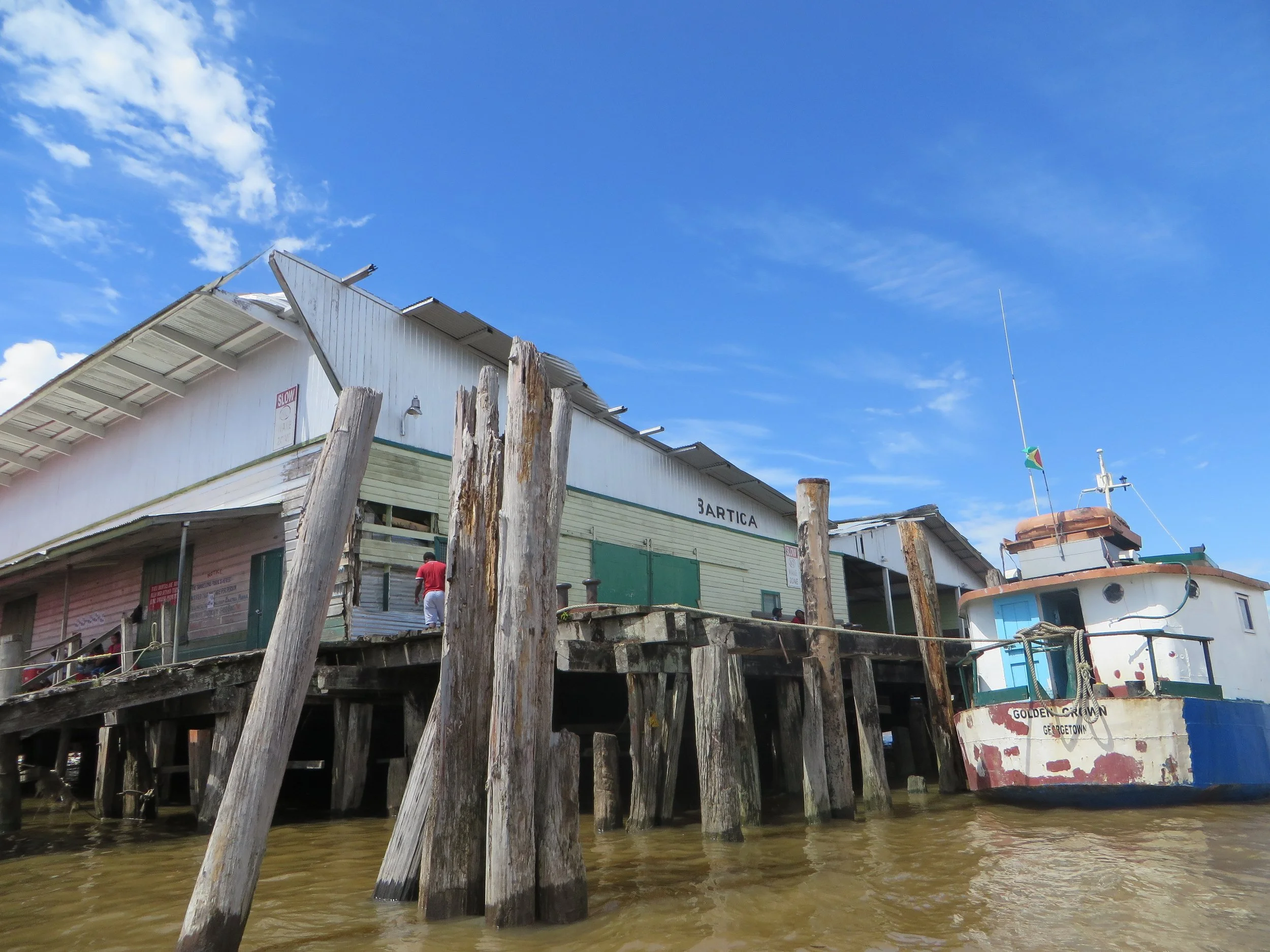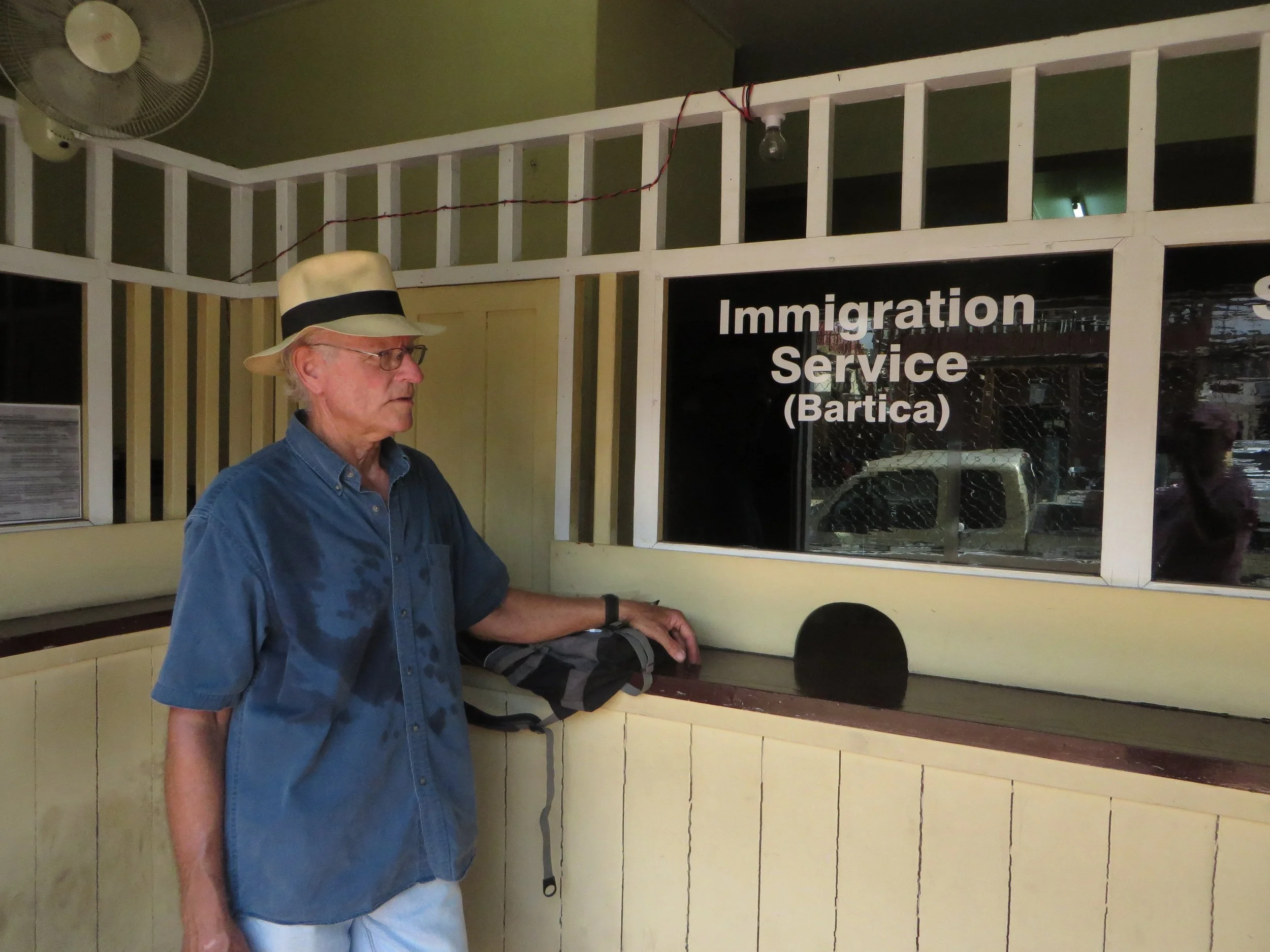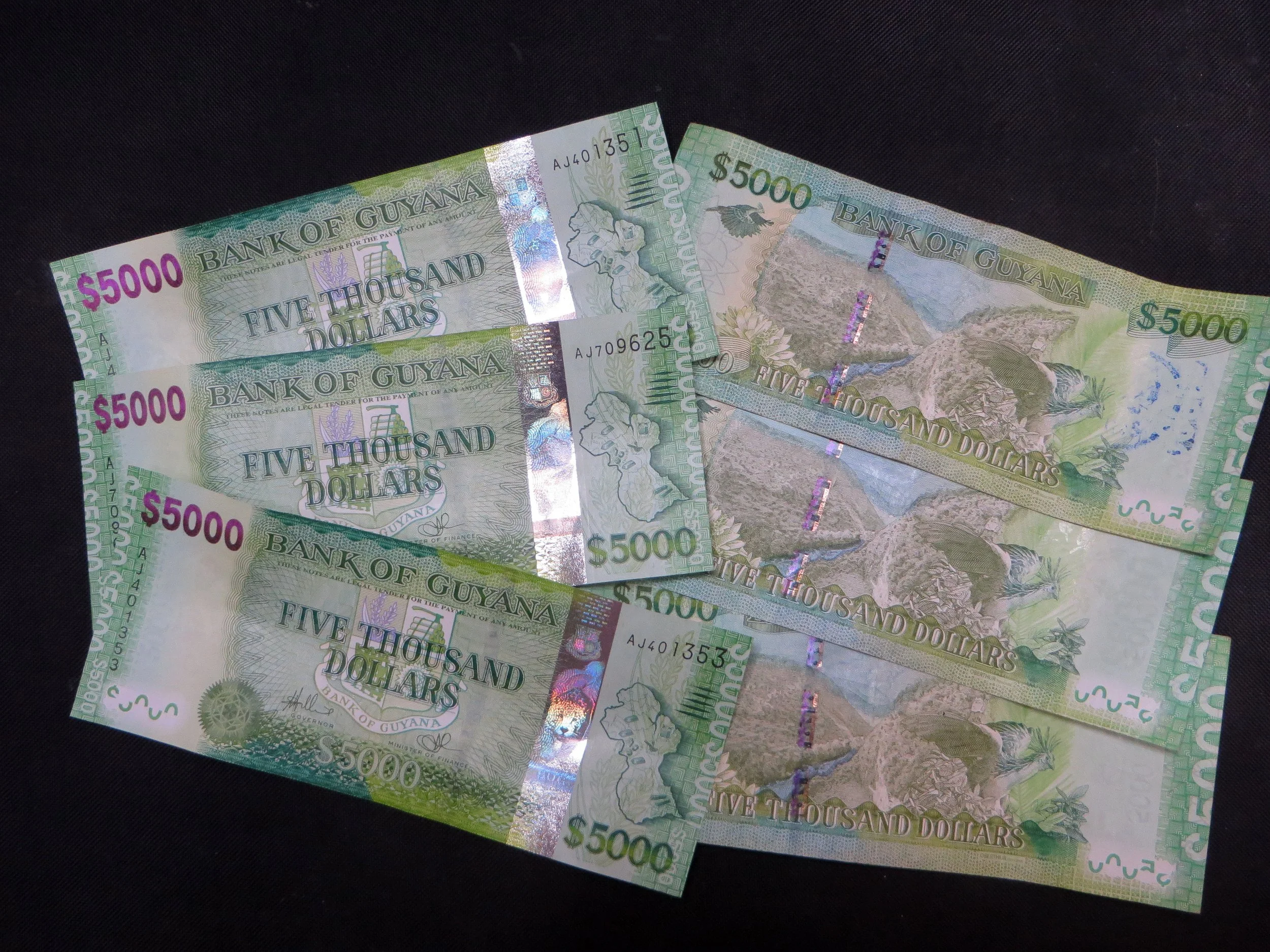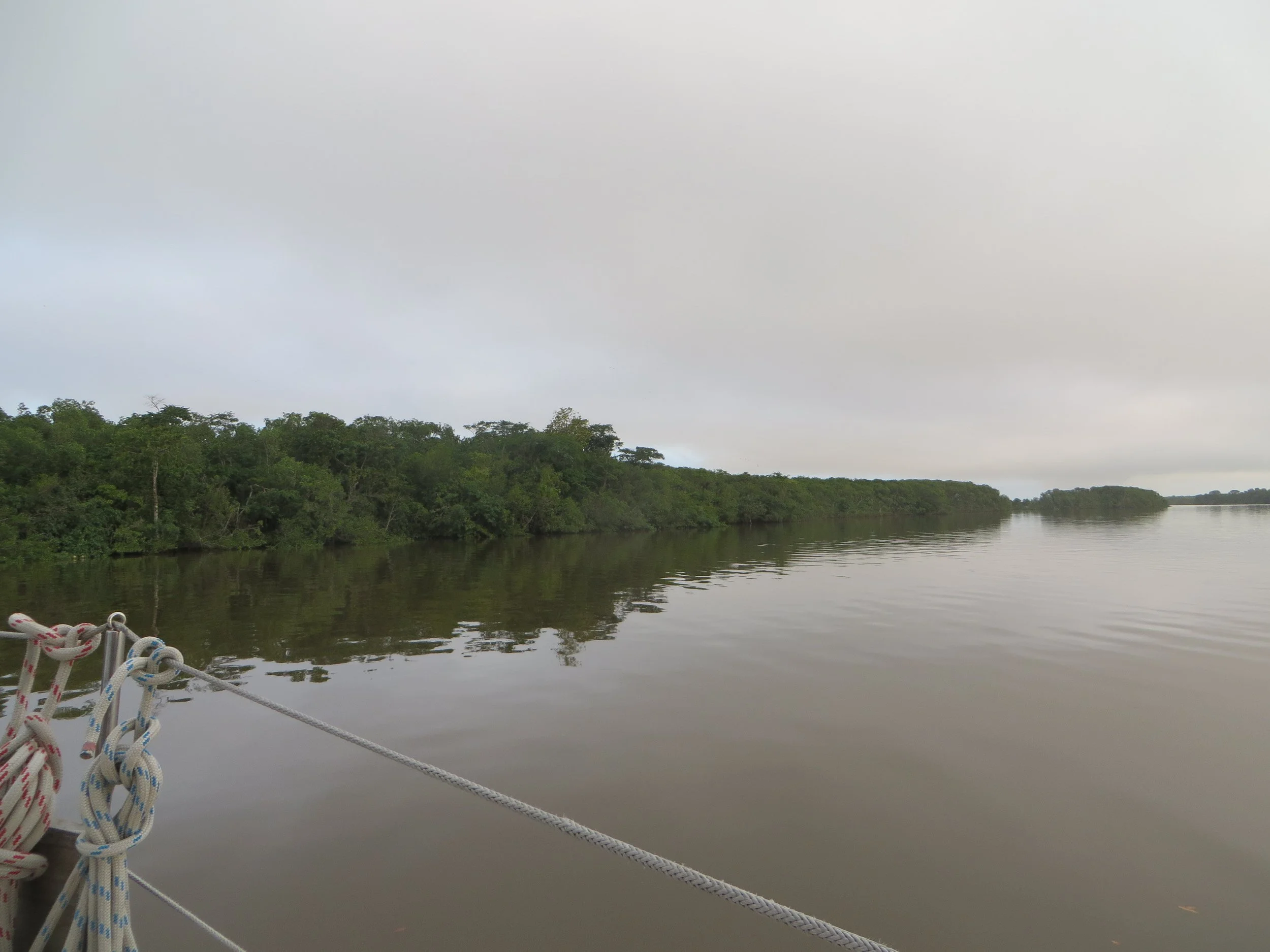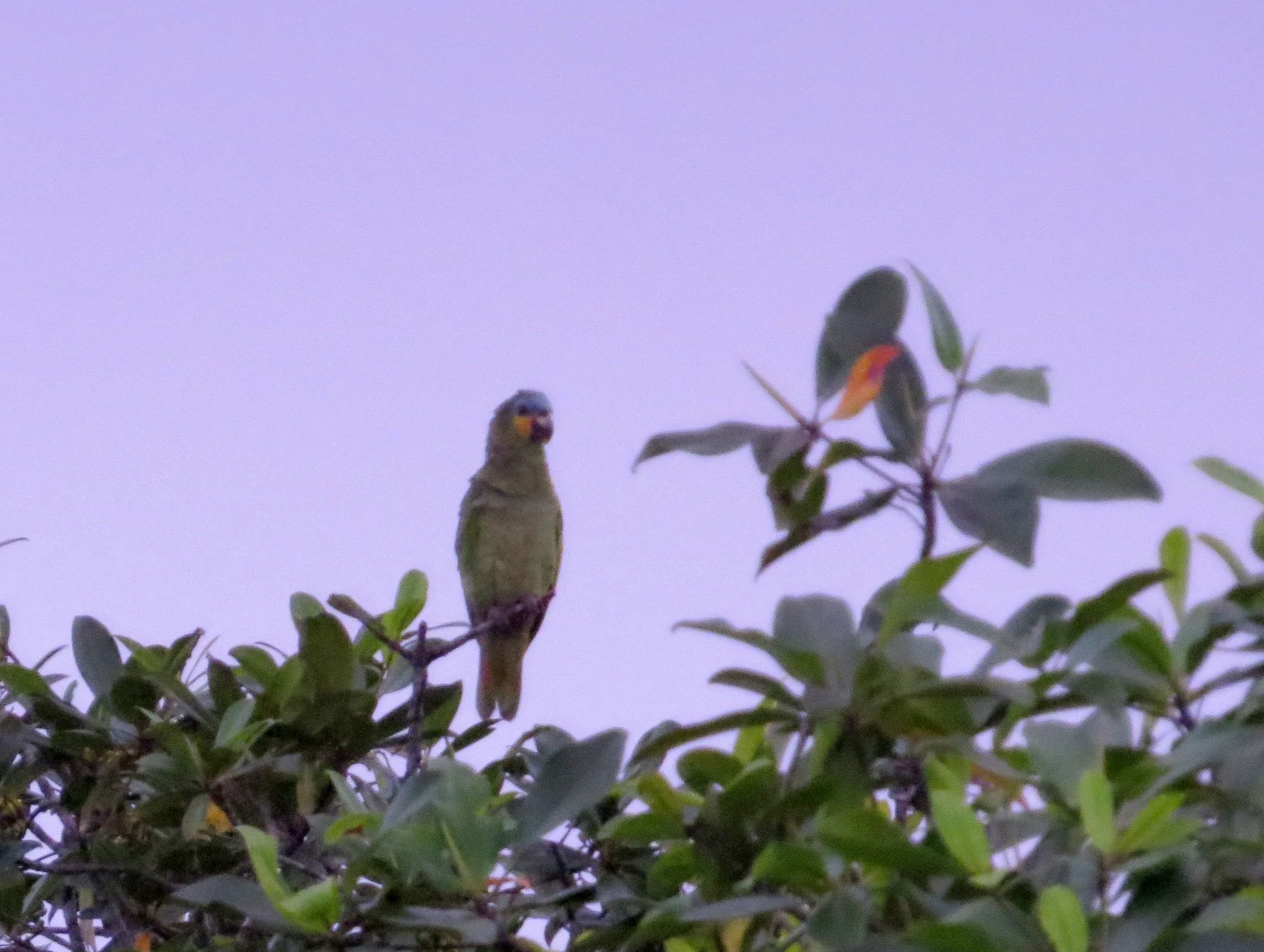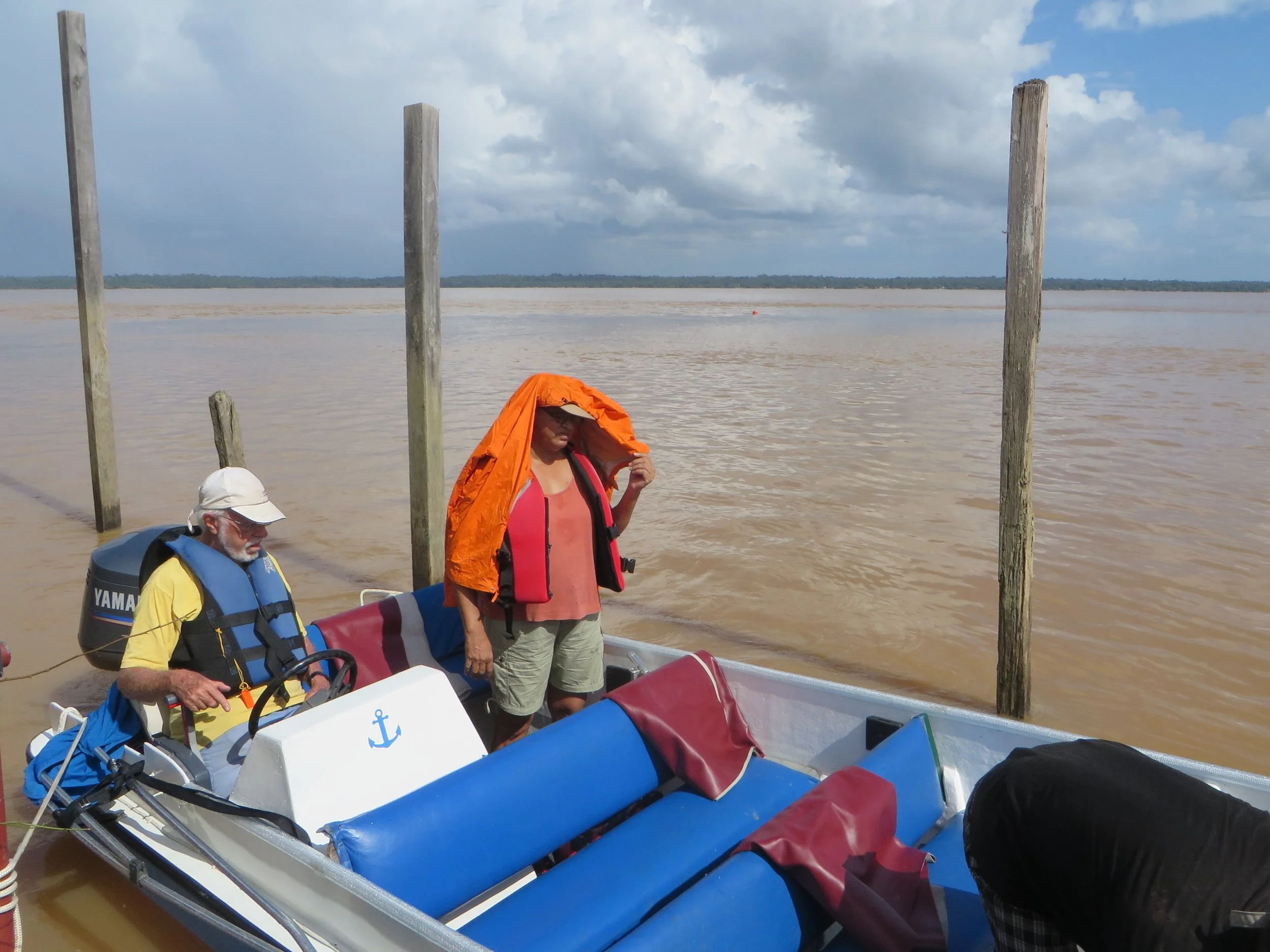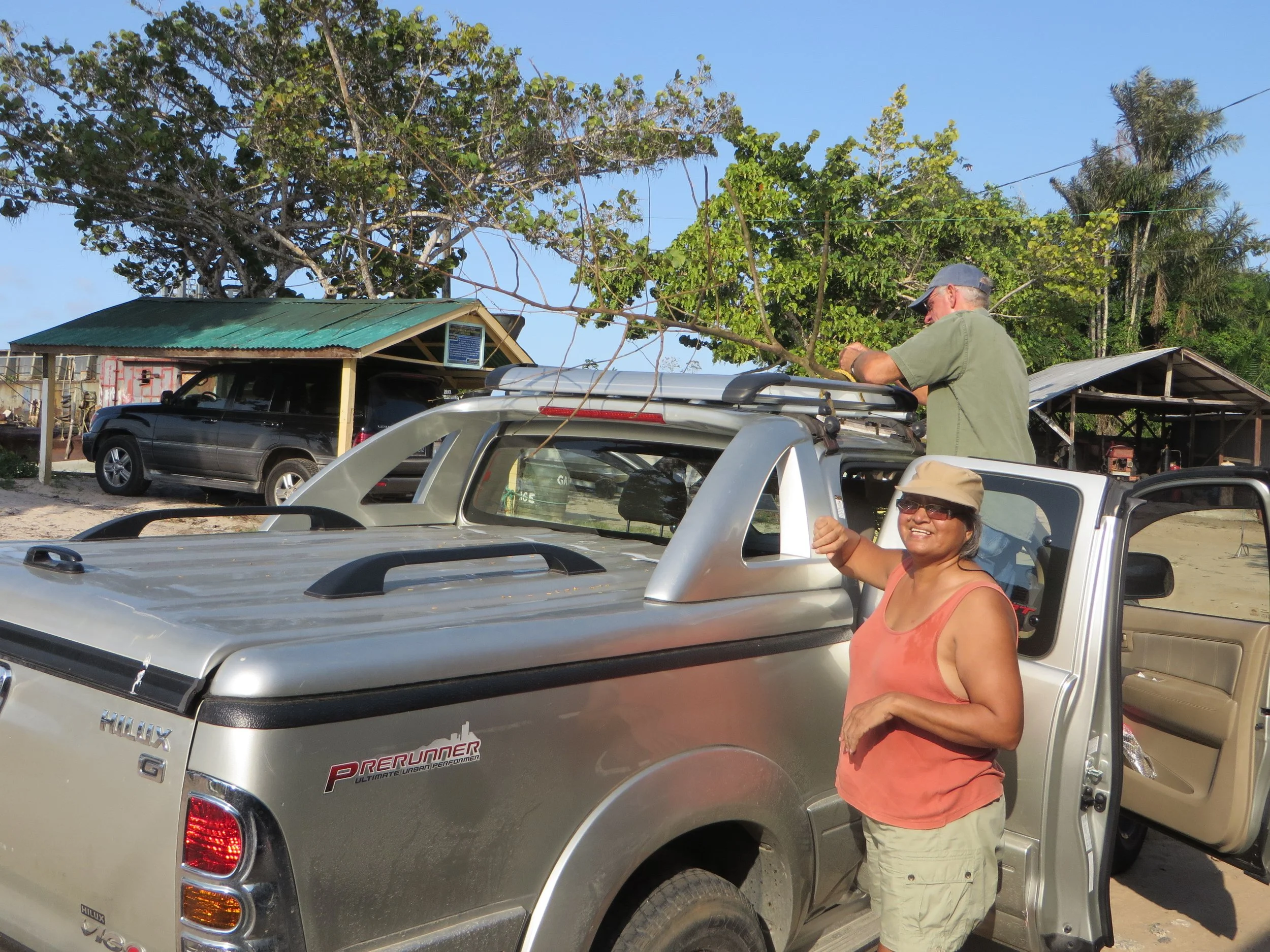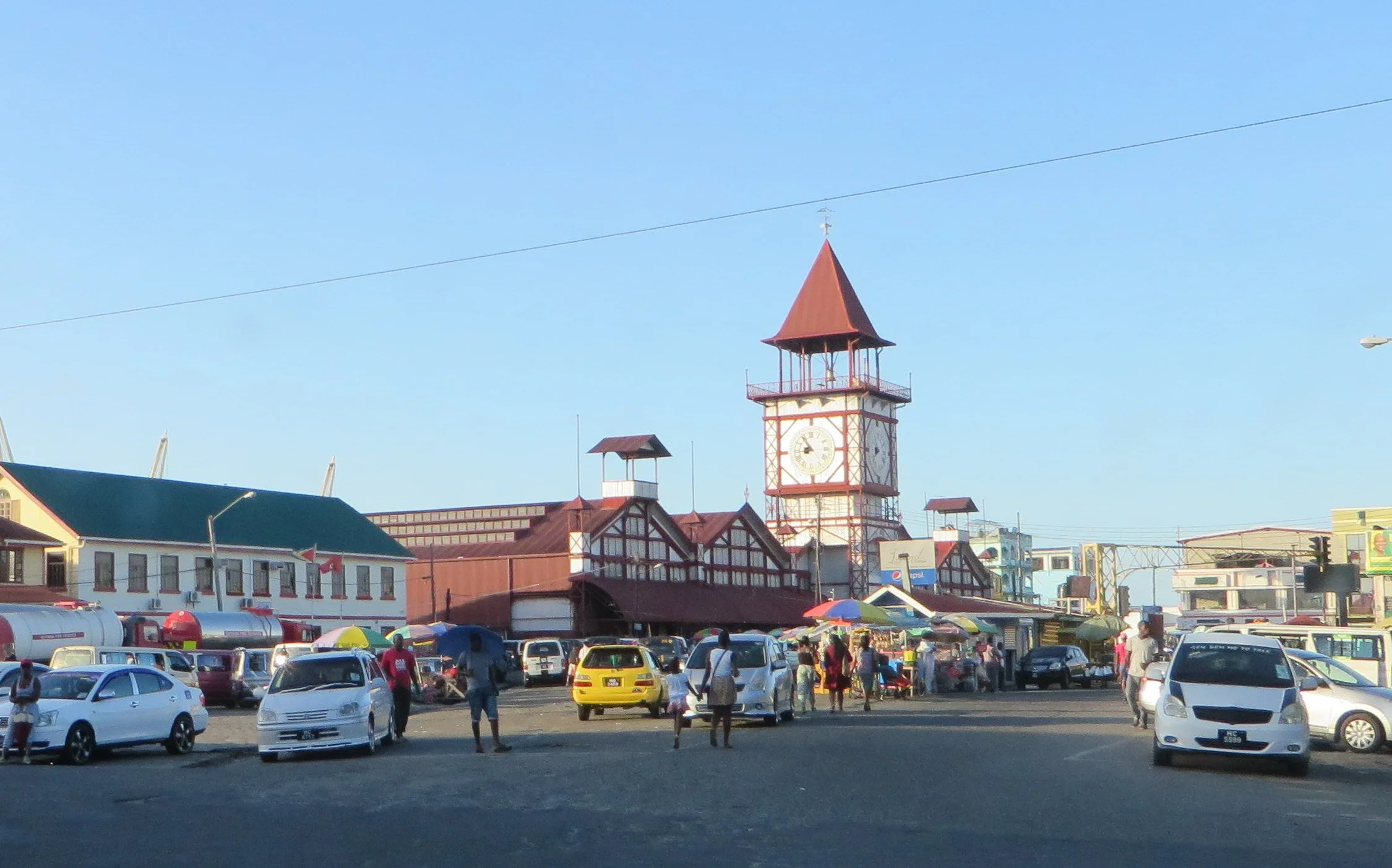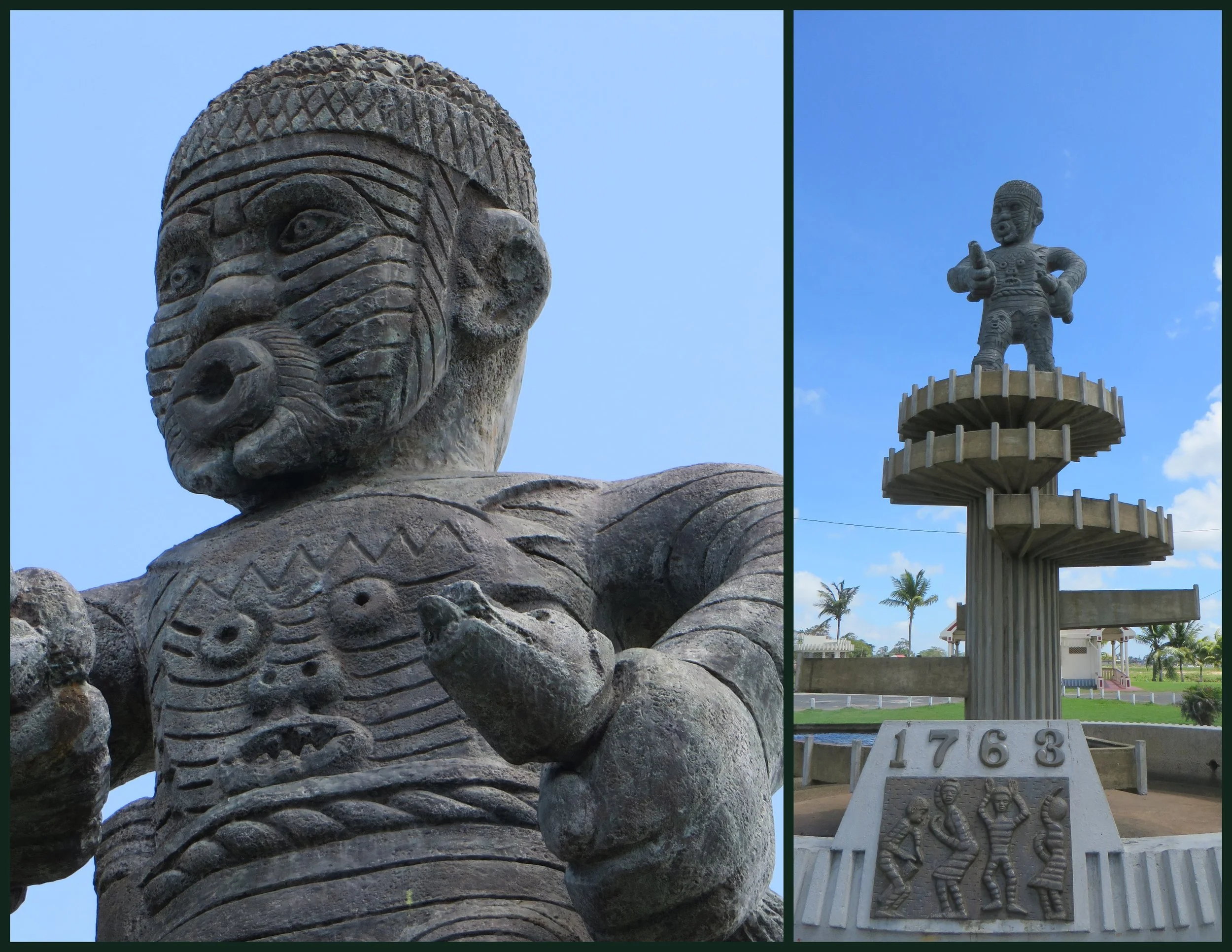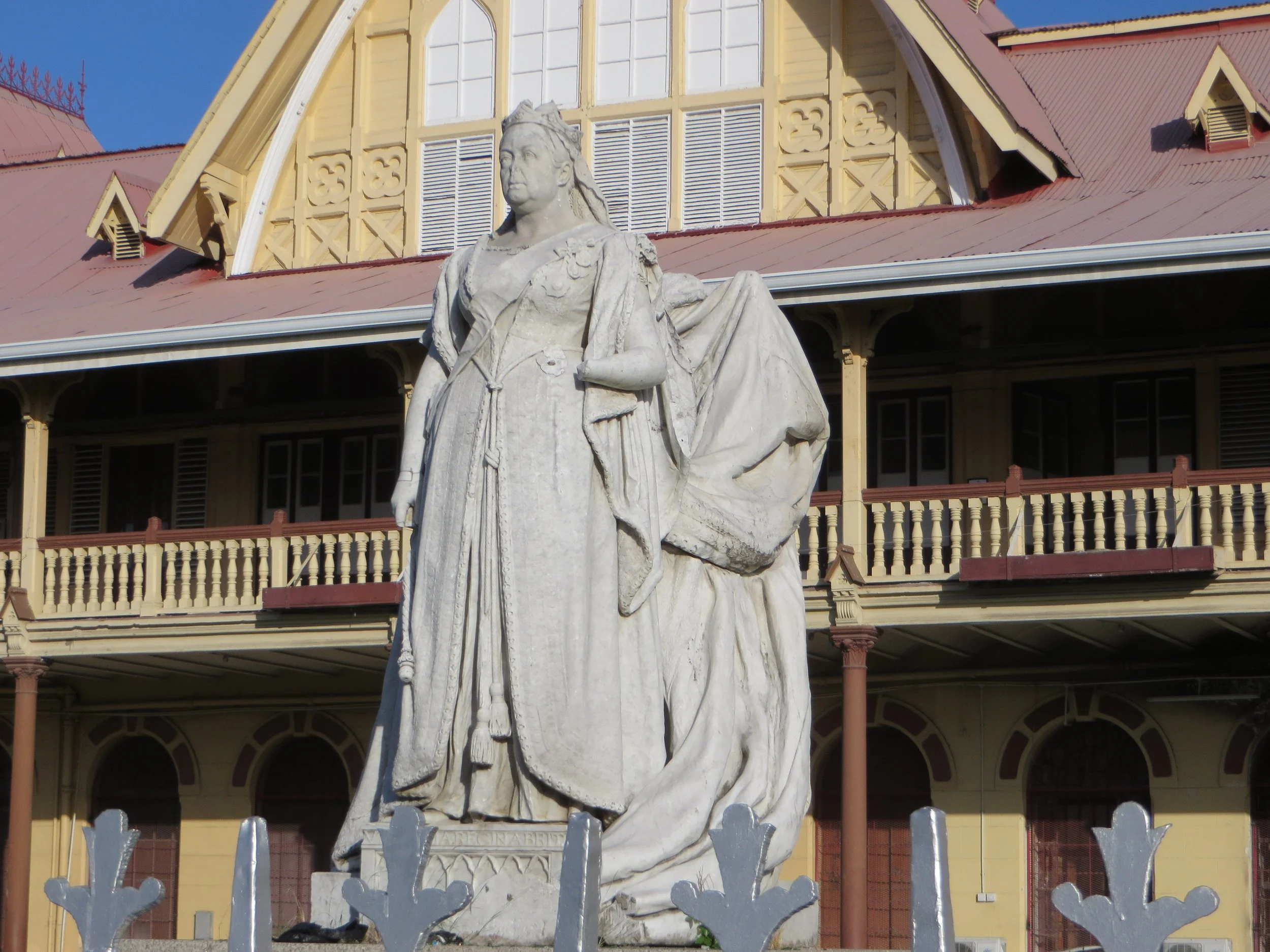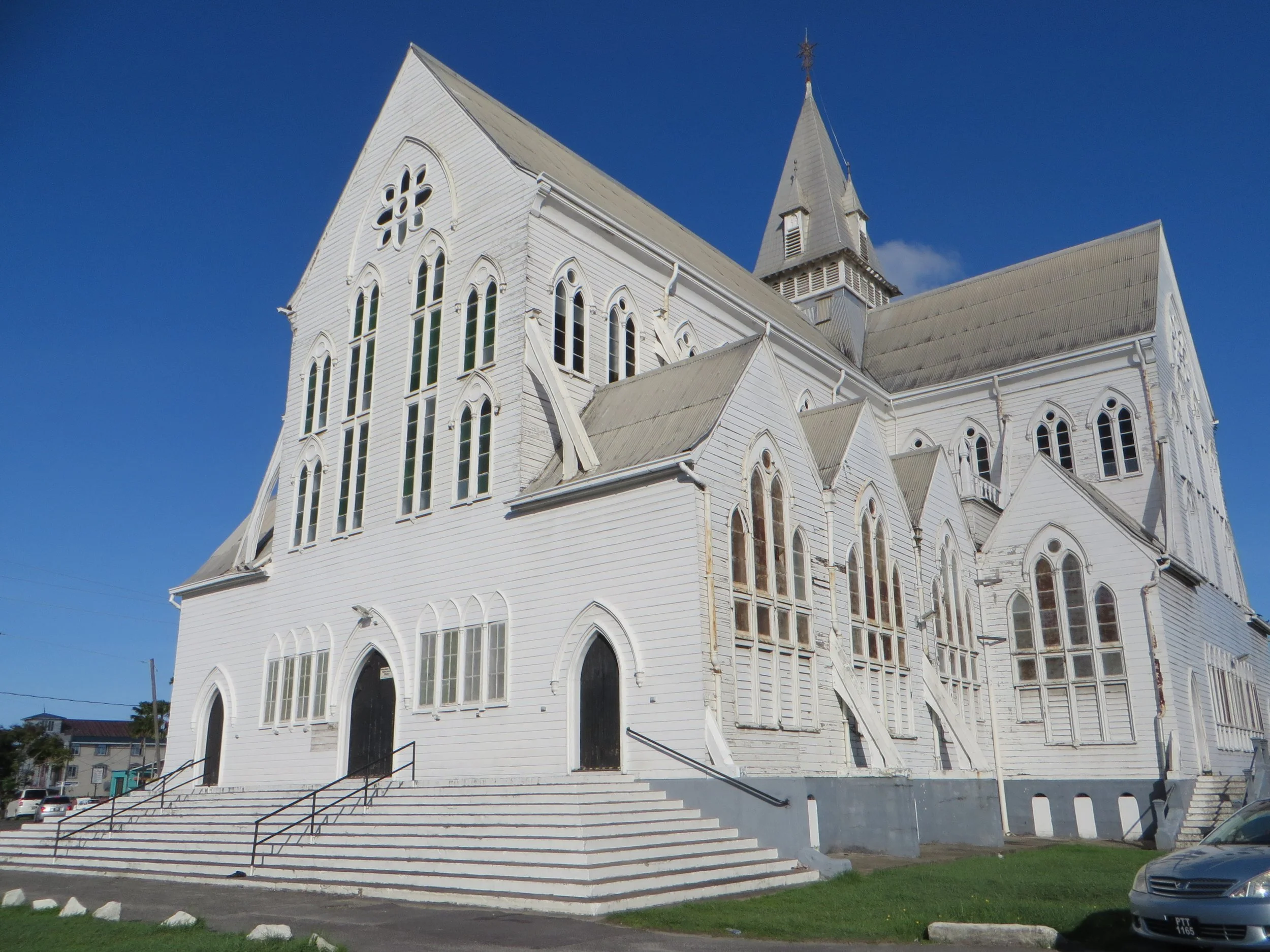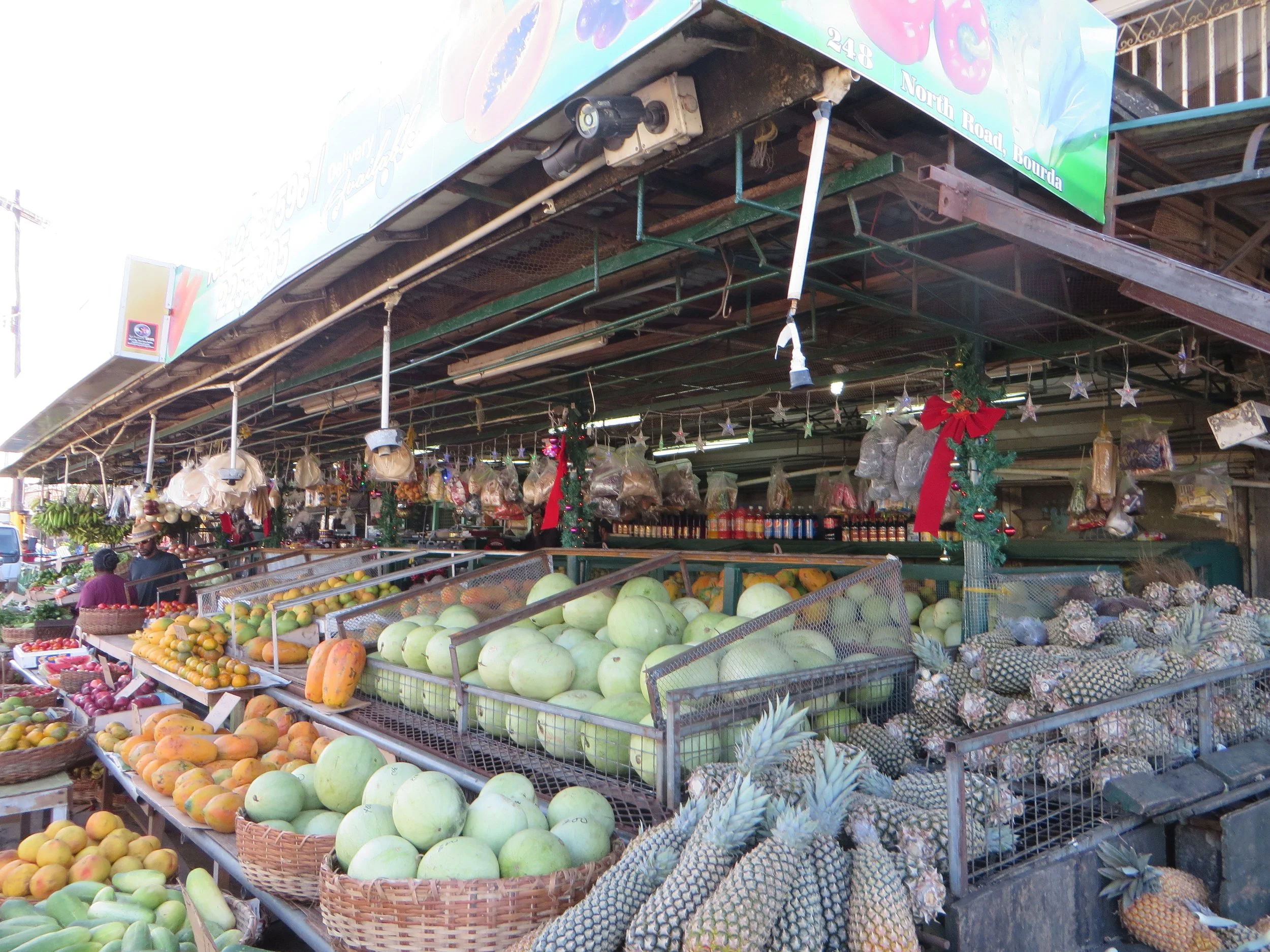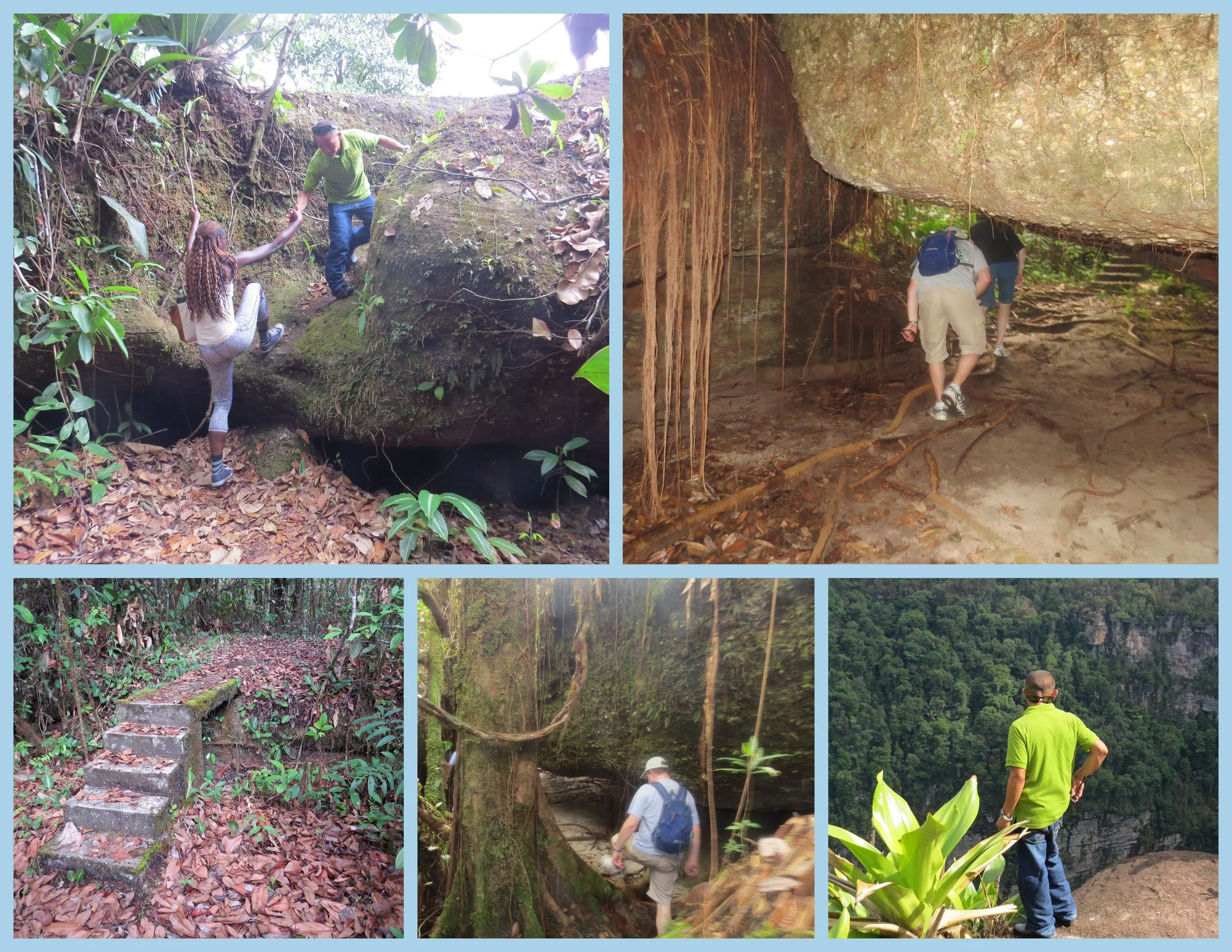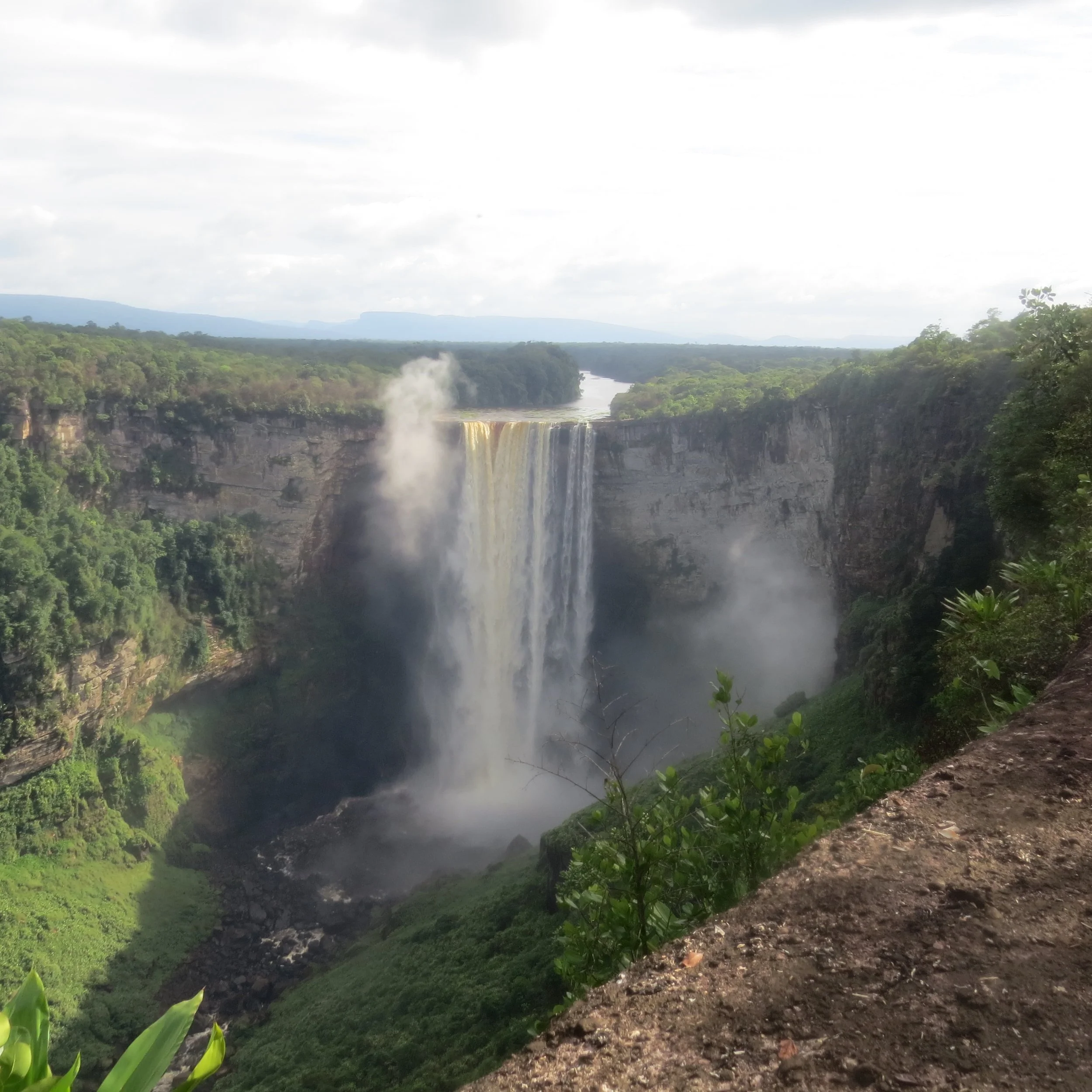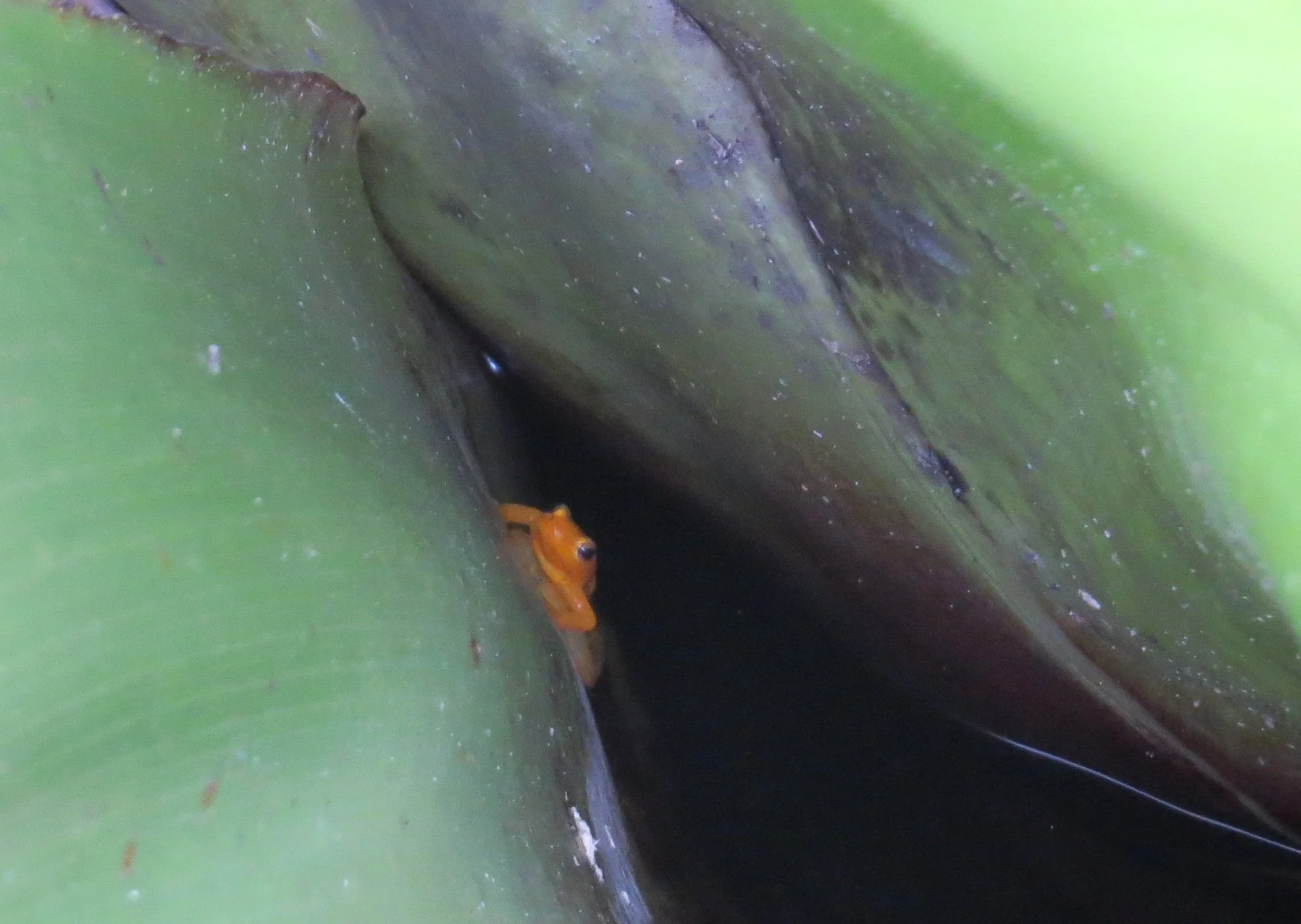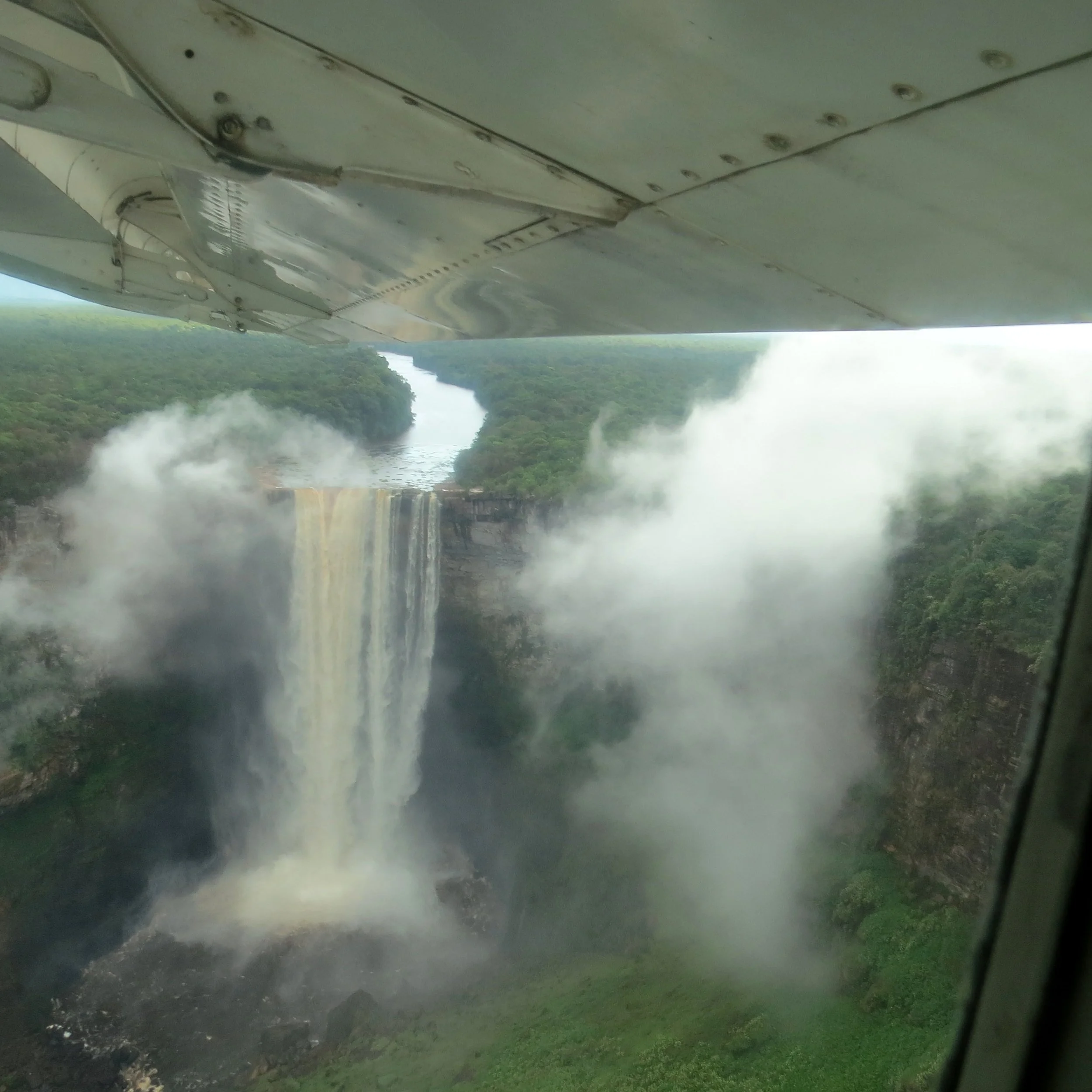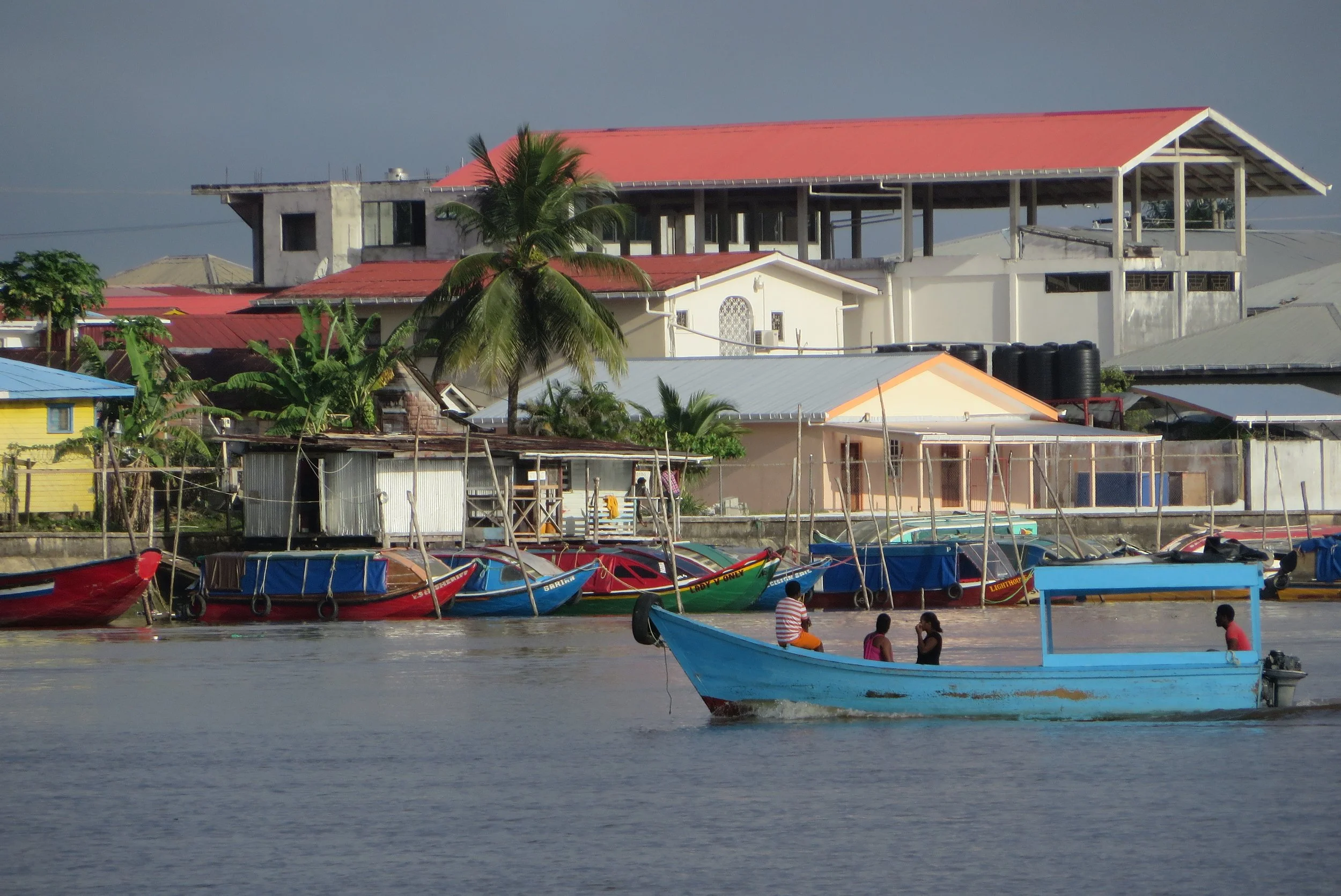Guyana... Cowboys, sugar, gold and Kaieteur
The third smallest country in South America, Guyana, an Amerindian word, translates to "land of many waters" due to its huge network of rivers and streams. It’s a multi-ethnic country of miners, farmers and timbermen. There’s an Old West lawless feel that pervades its streets that elicits both excitement and wariness.
The Guyanese national flag is called “the Golden Arrowhead”.
Republic of Guyana
Capital: Georgetown
Population: ~780,000
Currency: Guyanese dollar (GYD)
Area: 62,675 mi² (214,969 km²), a bit larger than the state of New York
Language: English although Creole, Hindi, Urdu and several AmerIndian dialects are also spoken.
Officially named the Co-operative Republic of Guyana, it is the third-smallest country in South America. Nestled between Venezuela to the west and Suriname to the east, it borders Brazil to the south and the Atlantic sweeps its shore on the north. In the 17th century, it was originally a Dutch colony, then in 1815 the area was occupied by the British and became British Guiana. Guyana became independent from Great Britain in 1966. Its main industries are mining (diamonds, gold and bauxite), timber and sugar processing. We visited by land and sea in November-December 2015 and sampled a little bit of city, a little bit of country and a little bit of nature. Come explore with us.
We entered Guyana by sailing up the Essequibo, Guyana’s longest river. The change in water color from the blue Atlantic waters to the mud brown river waters was distinctly noticeable. You can read our blogs about the 3-day sail to Guayana here and Travel up the Essequibo here.
Welcome to Bartica
Travel up the Essequibo River was interesting, but required lots of concentration since our charts were not accurate and most navigational markers were missing. We were quite relieved when we finally arrived in Bartica, (pronounced BAHR-ti-kah). A small port town of ~15,000+ people, it is located on the Essequibo River, at the confluence of the Cuyuni and Marzaruni Rivers, about 50 miles upriver from the Atlantic. It's called the “Gateway to the Interior” as it's the key jumping off spot for freelance miners, known as pork knockers, that scour the alluvial fields of Guyana's interior for gold and diamonds. Read more about Pork Knockers here.
Busy Bartica dock as viewed from the dinghy
After tidying up and making sure the anchor was firmly set, we ventured ashore. Finding a place to tie up the dinghy was a challenge, but we managed. Our first stop was Immigration and after completing our entry forms the immigration officer stamped our passports and directed us to an ATM to obtain Guyanese dollars and pay our Customs' fees.
Visiting Bartica was an experience in itself. It reminded us of Dawson City in the Yukon Territory or Leadville, Colorado, high in the Rocky Mountains or even Iquitos, Peru on the banks of the Amazon. A kind of 1950s-ish, scoff-law cowboy town… isolated and agrestic. The folks who live here are mostly miners or purveyors of supplies and services for miners.
There is a lawless kind of feel to the place though the police station is right on First Avenue, behind a sturdy fence topped with razor wire. The roads are unmaintained. There's trash everywhere ... on the streets, in the gutters, vacant lots, and along the shore. Cars and trucks park haphazardly anywhere there's room and sometimes where there's not. Big olive green mining trucks full of fuel barrels, equipment and supplies take up all of the width of the roads sometimes, forcing other cars to back up out of the way. The narrow, pot-holed streets are jammed with pedestrians and traffic, but it seems to work. Traffic noise is trumped by loud music blaring from the booths of vendors selling pirated CDs and DVDs. Orderly chaos, maybe?
The bars, most without signs, do a land-office business and seem to be open all the time, dispensing cold beer and spirits in volume. People ... men and women … walk, or sometimes stagger, along the streets swigging beer day and night (not unlike Vegas or New Orleans, I suppose), talking loudly or maybe singing. We hear music ashore late into the night. Like hard-working miners everywhere, when there's a bit of a jingle in their pocket and there's time away from the harsh, backbreaking mining routine, it's time to relax and throw a few beers back (and then a few more).
Despite the trash and the potholes and the inconveniences, there is a definite Old Wild West charm to Bartica that we appreciate. People are friendly on the streets, look you in the eye, smile, and say hello. We stopped by one shop to ask a question and were invited to a Hindu pre-wedding party later that evening. People are rugged and self-sufficient here, living in wild isolation, but their friendliness shows through a rather hard exterior.
The Grass Islands
While reading Doyle's Cruising Guide to Guyana, I noted a Noonsite comment about things to do near Bartica … “Some nights must also be spent at Grass Islands, where hundreds of parrots go every night to roost, a sight you will be unlikely to see anywhere else in the world, not to mention the sounds.” We decided to get away from the big city for a night or two and check out the Grass Islands, just a mile or two on the other side of the Essequibo.
It was dusky by 5:15 and still no parrots. We thought we'd been misled when we suddenly heard a faraway squawk, then another, then another. Flapping their wings in the awkward, comical way that parrots do, and squawking loudly all the while, they came in pairs, then five pairs, then flocks of 20 and 30 pairs. They came from the south mostly, from upriver where it's less inhabited and more densely forested. The sound volume was incredible … chaotic, frenzied “Honey, I'm home” squawks … a 45 minute concert of disharmony.
Hurakabra on the Essequibo
Via an introduction from an old cruising friend , Kit and Gem Nascimento e-mailed us and invited us to anchor off their Hurakabra (Her-rah-KAH-bra) River Resort and avail ourselves of the amenities… showers, internet, a place to hang out on land and more. We headed downriver until the distinctive green roof of Hurakabra came into view. The place looked positively inviting. A long pier extended out into the river with a floating dinghy dock. Tall palms and bamboo were interspersed with tall deciduous trees. We could hear birds singing and someone waved from the shore.
Read more about Hurakabra in our blogs. It was a fascinating place.
Georgetown - Guayana’s Big Smoke
Lonely Planet describes Guyana's capital city, Georgetown, as “dirty, expensive and dangerous.” With such an appealing reputation, we felt obligated to visit... if only to compare it to Colon, Panama, currently at the top of our “dirty, dangerous, least-liked” city list. We were up for some adventure and decided to spend a couple of days there.
Getting to Georgetown from Hurakabra can be a challenge, but we lucked out. We left Cups on the hook under the watchful eyes of Mike, the Hurakabra caretaker, and hitched a ride to Georgetown with our hosts, Kit and Gem. They have a “fast boat” which ate up the miles downriver pretty quickly. 35 miles at 35mph jarred a few fillings loose along the way. We were there in less than an hour. Kit and Gem are both native Guyanese and there are no better tourist guides than locals.
They gave us a lift into the city offering a commentary as we drove. We got our first glimpse of Georgetown, and passed several landmarks … City Hall, Stabroek Market, St. George's Cathedral, the High Court with Queen Victoria's statue presiding over the premises… all places we intended to visit during our stay.
The French originally colonized Georgetown and called it Longchamps back in 1782. The Dutch took over in 1784 and renamed it Stabroek. The Brits took over in 1812 and renamed it once again… Georgetown, in honor of King George III (known for two things … losing the American colonies and going mad). Located between the banks of the Demarara River and the shores of the Atlantic, this small city is below sea level and protected by the Georgetown Sea Wall.
Our hotel room at the Signature Inn recommended by Gem was great and within walking distance to sights around town. Our first foray was to the botanical gardens. We wandered around for awhile and then sat on the steps of the Kissing Bridge to watch monkeys play in the trees. Toucans were perched in the treetops.
From the gardens, we walked another couple of blocks specifically to see an impressive sculpture by Philip Moore commemorating Cuffy, a national hero and the leader of the 1763 slave rebellion against plantation owners.
On another day, we continued our city adventure and walked to Georgetown's majestic City Hall. Built in 1889, it's in desperate need of repair, but the grandness of its Neo-Gothic colonial architecture shows through.
Georgetown City Hall
Queen Victoria stands regally and presides over the proceedings at Guyana's High Court (Victoria Law Courts) buildings (1887). We continued on to St. George's Cathedral. Built in 1899, this Gothic style Anglican church was once considered the “world's tallest wooden building”. Constructed primarily of greenheart, a local hardwood, it, too, is in dire need of restoration and work was in progress on what has become a national monument.
Dating back to 1792, the market area is total chaos where you can buy anything from broccoli to brassieres and toilet plungers to gold. The stalls are tight and crowded. Hawkers and vendors are shouting and touting their wares. People are shoulder to shoulder, hustled along by the flow of the throng. The smell of rotting veggies, odd spices and human sweat prevail. Still, you can feel and absorb the frenetic energy of the place as you pass through. We were warned of pickpockets here, but had no problem.
We headed to the relative calm of the National Museum. It's housed in a non-descript building and is part natural history and part cultural history … although neither is done particularly well. The highlight of the museum is the giant sloth exhibition which has its own room. Evidently giant ground sloths (megatherium) once roamed the area, the skeletal remains of which were discovered by a miner in Guyana's interior. Considered to be one of the largest mammals that ever walked the earth, these guys were about the size of a modern-day bull elephant.
All in all, Georgetown was a surprise. It's a third-world city, without a doubt, but it seemed that there was a major effort underway to clean-up, renovate and restore. Traffic was horrendous and crazy and both driving and walking were risky (like many big cities). The people, however, were warm, friendly and helpful. Beyond the colonial buildings, parks, statues and markets, there was so much to be seen by just wandering around and observing. We walked during the day and ventured out at night by taxi.. We didn't flaunt jewelry or cash. We were alert and practiced typical street-wise, any-city behavior. We never felt threatened or at risk for our security. You can read a more detailed account of our time in Georgetown by checking out our blogs here.
Kaieteur National Park - Guayana’s Legendary Waterfalls
While we were busy exploring Georgetown, Gem had arranged a tour to Guyana's legendary waterfalls at Kaieteur National Park. Described as the world's widest, single-drop waterfall, Kaieteur is considered a must-see while in Guyana. Located on the Potaro River in the Amazon rainforest, its cascade plunges 226m (741ft) in a single drop and a total of 251m (815ft) before reaching the gorge below. That's about five times higher than Niagara Falls and more than twice the height of Victoria Falls. According to the World Waterfall Database, the average volume of water flowing over the falls is somewhere around 23,000 cubic feet per second, making this a rare combination of a very tall waterfall on a high-volume river.
We departed from Ogle Airport in Georgetown, an airport used expressly by tour planes. Along with the pilot and 10 other passengers, we crammed into the tiny, single-prop Grand Caravan C208B plane for a one-hour flight to Kaieteur. It wasn't the safest-looking plane. The pilot mumbled something about seat belts, revved up, and we were airborne. Thankfully, take-offs equalled landings and we arrived at the national park.
Our AmerIndian guide, Max, met us as we deplaned and the tour began. We stopped frequently along our trek to observe and learn more about some of the unusual, endemic plants and animals in the area like the carniverous red drosera kaieteurensis (yup, Max knew all the Latin names) that invites insects to dinner, luring them with its bright color and sweet, sticky sap, then gobbles them up.
Three separate trails allowed us different views of the falls. The first trail was quite straightforward, except for the labbaria (fer de lance) snake that was curled up against a stepping stone in a narrow part of the trail.
The second viewpoint was a bit more strenuous to get to. We went over a narrow moss-covered plank bridge, ducked down under huge boulders, around massive tree roots, through dense foliage and finally up a steep, muddy incline before reaching our destination. We could hear the thunder of the falls and feel the vibration before we saw them.
Along the trail we saw huge bromeliads (Brocchina micrantha); some were 8-10' (2-3m) tall. Within the tanks (axis of the leaves) of these giants live rare, tiny golden frogs (Anomaloglossus beebei). The frog is born, lives and dies here and in all the world, is only found on the Kaieteur Plateau. Indigenous people once collected poison from the slime that oozes from the frog's skin and used the toxin on blowgun darts and arrows. The curare-like toxin is said to be 160,000 times more powerful than cocaine and kills nearly instantly. Omar pointed one out to us. It was so tiny, it was difficult to see as it peeked out at us. Unfortunately, with 11 other people waiting to see it, we were rushed (I hate that!) and the photo opp was only seconds long per person before we were rushed along to another viewing point.
We reached the third viewpoint on an easy trail which opened to a wide, level area from which to view the falls. Signs cautioned us to stay at least 8' from the edge since there were no rails, but most folks ignored the caution, as did the guides.
All too soon, it was time to head back to the park headquarters. Cold water and plantain chips were waiting for us and then we re-boarded our tiny plane to head back to Georgetown. On the return, the visibility was much improved. The pilot flew over the falls providing us with a good aerial view.
The view of the falls from the plane was stupendous.
We splurged and took a taxi for the hour-plus-long ride from Georgetown to the Parika Stelling where we caught a river taxi back to Bartica. We had thought we'd take a much cheaper mini-bus, but with luggage, full backpacks and some provisions, the thought of cramming into the mini-bus on a sweltering, muggy day was not appealing. When we arrived at the stelling, we were quickly ushered to a Bartica-bound river taxi… a marine version of the mini-bus with 30 people, their luggage and freight aboard. It was stifling. The boat finally left for Bartica. The ride was fast and bumpy. Wide, low windows provided relief from the stuffiness and heat, but offered no protection from being splashed. Mike from Hurakabra met us at the ferry dock and whisked us back to Nine of Cups.
Though we really enjoyed Guyana, the clock was ticking to get Cups to Trinidad. In the morning, we did last-minute chores, said our adieus and we were off with the noonday ebbing tide, following our track back down the long and winding Essequibo River. A short-lived 30-knot headwind and a torrential downpour was our send-off within minutes of our departure from Hurakabra, but it soon calmed and cleared. The ebbing tide did not afford us a long enough window to negotiate the entire 50nm downriver run. We stopped for the night just off Fort Island, thinking we'd visit the island in the morning. Our plans were thwarted by heavy morning rains. We caught the early afternoon tide once again, but made it only 15 miles before the afternoon headwinds beat us back. Getting down the Essequibo was proving more difficult than getting upriver. We had 20-knot head winds and with the wind against the current, the waves were short and choppy, making it slow going. Despite the help of the ebbing current, it took us two days to get down the river.
We anchored off Leguan Island in order to minimize our morning run to the Essequibo's mouth. The winds were predicted to be better and we preferred to negotiate the endless fishing nets in the daylight. Early on the third day, we hauled anchor with a bright crescent moon and a twinkling morning star looking down on us. Three hours later, we broke away from the brown Essequibo and we were back in the Atlantic, en route to Trinidad. The sky was blue, the wind was ENE at 15 knots and the current favored us. Once again, we're on our way.
Before we leave, a little Guyana trivia for you …
Guyana is the only country in South America with English as its official language although Creole, Hindi, Urdu and several AmerIndian dialects are frequently spoken.
Guyana is probably best remembered as the site of the mass suicide at Jonestown in 1978. Jim Jones, the leader of the People's Temple Movement, convinced 900 of his followers that it was “time ... to meet in another place”. They all drank cyanide-laced red Kool-aid and were dead within an hour.
Georgetown, Guyana's capital and only large city, lies 13 feet below sea level at high tide. A sea wall and an early Dutch canal system keep the town from flooding and provide drainage.
Demerara sugar, a brown, raw cane sugar, gets its name from the Demerara River in Guyana. The Guyanese sugar industry, with a 300-year old history, is nationally controlled (Guysuco) and huge.
Guyana's first Olympic medal was won by Michael Parris who got a bronze for boxing in 1980. Cricket, introduced by the British. is the national sport and is played religiously.


